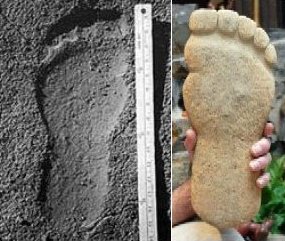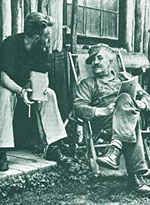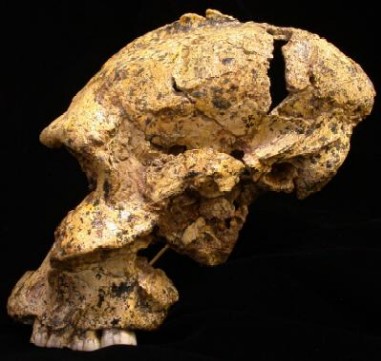Wildmen in North America & Bigfoot Emerges
Posted by: Loren Coleman on March 20th, 2007

The Real Bigfoot and Genuine Bigfoot Tracks
Part 2: Wildmen in North America and Bigfoot Emerges
by Mark A. Hall
Wildmen in North America
The subject of Bigfoot is but one of several mystery primates for whom a long and involved record has been found to exist in North America. The earliest historical reference to a mystery primate dates to 1784. [4] We know of the details of an 1829 report from the Okefenokee Swamp in Georgia. [5] In recent decades accounts of sightings and hunts for hairy “wildmen” around North America in the 1800s have been turning up all over the continent. The idea was so commonplace in the 19th century that David W. Belisle put a hairy man-monster into his fictional account American Family Robinson published in 1854. [6] In the two halves of the twentieth century people began to take these events seriously. They began to organize these strange stories in a crude fashion.
Around 1900 Bigfoot began to appear in collections of folklore in the Pacific Northwest identified with Indian names that were similar to the Anglicized name of “Sasquatch.” That word was coined in imitation of those Indian names by John W. Burns. In the early years of the 1900s Burns recognized that something was being overlooked when the Indians told him stories of encounters with hairy giants. He was a lone voice for many years. [7]
Giant footprints in the snow were mentioned when the Indians told of the Kaigyet, which “had the face of a human being, it was exceedingly tall, about a fathom thick in the body, and was covered with hair.” A hunter came back to his camp to find “his mother had disappeared, carried off, apparently, by some monster that had left enormous footprints in the snow.” The story of the Kaigyet was told among the Carrier Indians who lived around the headwaters of the Fraser River in British Columbia. [8]
In the second half of the century Burns was succeeded by men such as John Green and Rene Dahinden. They also recognized that something remarkable existed in the Pacific Northwest. [9] They were joined in their quest to understand Bigfoot by many others as the years and decades passed. They have recorded the sightings and told the history of the early pursuit of Bigfoot.

John Green was instrumental in recording the experiences of Albert Ostman who spent several days in the company of a family of Bigfoot creatures in British Columbia. With his extraordinary story we learn some of the details of the appearance and life of these creatures who have otherwise been seen all too briefly. [10]
In 1961 much of the Bigfoot lore appeared in a book by naturalist and fortean writer Ivan T. Sanderson. He had traveled through the West from California to British Columbia meeting the Bigfoot sighters and the investigators. He told their stories in his book and in many popular articles. [11]
The appearance, habits, and tracks of Bigfoot are unique to the Pacific Northwest. The identity of Bigfoot per se was cemented by the Patterson-Gimlin film of October 1967. This historic event is, in effect, a Bigfoot-sighting for all of mankind. To watch that film is to have the experience some fortunate few have had over the last one hundred years in the Pacific Northwest. A genuine giant is seen and runs away. This is the experience that convinced many witnesses. We are able to view the film and examine the unique tracks left by the creature in the film. For many people the film and the tracks define Bigfoot in the best way. Along with similar sightings, a history of contact, and a few good records of tracks, the creature shown in the film represents Bigfoot as we understand it to exist in the modern day. I have referred to this type of being as “Patterson’s Bigfoot” in my works to distinguish it clearly. Ivan Sanderson called this type of creature the “Neo-Giant.” The application of the word “Bigfoot” to things all over North America and around the world is grossly misleading.
Very few exceptions have been detailed to show the movement of this Bigfoot outside of an area from California to the Alaskan panhandle. Other creatures large and hairy exist. They bear a superficial resemblance to the Bigfoot of the Pacific Northwest, but that is where the similarity ends. The records from the 1800s through the 1900s indicate other mystery primates with different origins, histories, appearances, behaviors, and tracks. We will return to the subject of this context for Bigfoot later.

Bigfoot Emerges
The identity of Patterson’s Bigfoot or the Sasquatch has been discussed for a long time as probably originating with a type of fossil primate called Australopithecus robustus, also known as Paranthropus. This primate is known to have existed in Africa and Southeast Asia. At some point in the past it migrated into the New World just as human beings did many tens of thousands of years ago. The absence of recognized fossil finds in the New World is the result of 1) no one looking for remains other than human, 2) the geological record of repeated glaciations, and 3) the lack of preservation for the large bones that have turned up and then been lost or misplaced. Such cases were discussed by me in 1992. [12]
Much of the notoriety for the purported existence of the Sasquatch in the Northwest took place in the 1950s, prior to the publication of the first stories of a giant and hairy “Bigfoot” in California in 1958. [13] It has been asserted that the name was used in popular discussions about large footprints noticed in the woods prior to that publication. The word appeared in print in the pages of the Humboldt Times newspaper. Items there told of the find by Jerry Crew of large tracks near Eureka. Here is when the record of Bigfoot and its counter-part in Canada both blossomed. Also the incentive to fake large tracks in the wilderness was born with the fame that attached to the 1958 events.
The excitement over Bigfoot began in a period of road construction into the woods of Northern California. One of the workers who found odd tracks was determined to do something about them. Jerry Crew first saw tracks in August 1958. Then in early October 1958 Crew made a cast of a footprint 17 inches long and 6 inches wide. He ended up showing it to a newspaper editor, Andrew Genzoli. The resulting story and news coverage caused a sensation after 5 October 1958. Other tracks were found. People began to report large hairy creatures crossing the road in their headlights. Bigfoot had become established as a cultural item.
Tomorrow – Part 3: Hoaxing
Originally published in Wonders for December 2002 (Vol. 7 No. 4) pp. 99-125.
©2003 by Mark A. Hall. All rights reserved.
About Loren Coleman
Loren Coleman is one of the world’s leading cryptozoologists, some say “the” leading living cryptozoologist. Certainly, he is acknowledged as the current living American researcher and writer who has most popularized cryptozoology in the late 20th and early 21st centuries.
Starting his fieldwork and investigations in 1960, after traveling and trekking extensively in pursuit of cryptozoological mysteries, Coleman began writing to share his experiences in 1969. An honorary member of Ivan T. Sanderson’s Society for the Investigation of the Unexplained in the 1970s, Coleman has been bestowed with similar honorary memberships of the North Idaho College Cryptozoology Club in 1983, and in subsequent years, that of the British Columbia Scientific Cryptozoology Club, CryptoSafari International, and other international organizations. He was also a Life Member and Benefactor of the International Society of Cryptozoology (now-defunct).
Loren Coleman’s daily blog, as a member of the Cryptomundo Team, served as an ongoing avenue of communication for the ever-growing body of cryptozoo news from 2005 through 2013. He returned as an infrequent contributor beginning Halloween week of 2015.
Coleman is the founder in 2003, and current director of the International Cryptozoology Museum in Portland, Maine.










So he says that the Pacific Northwest bigfoot is entirely different from the Southern Bigfoot? Or am I getting the wrong message here?
No, that’s what he’s saying. Thanks again for presenting this to us, Loren.
Sorry, forgot to check the ‘subscribe to comments’ box last time.
Wild Hairy Ape like creature abound in all parts of North America in Indian lore Until we find real evidence of their current existence, i would refrain from casting them as Southern Bigfoot or Northern Bigfoot or for that matter Western and Eastern Bigfoot.Show me the Skulls, Skin, Feces, hair anything so that DNA methods can be used to identify the source.
Hi Bob,
I understand your reluctance to classify these elusive creatures into groups without further evidence. However, Loren’s extensive research led him to do just that in his book, “The field guide to bigfoot, and other mystery primates”. In fact if you look beyond North America the global differences between the hairy human-like creatures being reported are even more extreme, from true giants, to tiny little hairy hominids. These classifications aren’t willy nilly…and I think they are necessary in the pursuit of understanding. Of course I’m sure Loren will adjust his classification system as more evidence comes to light, but for now I think it works. Either way, if you haven’t read the book I mentioned, then you should.
Very interesting reading. I’m beginning to understand how much information is really out there. I think its good that so many people have different opinions and theories on this wonderful subject! It really brings about alot of good questions and helps to find new answers or try new experiments out in the field and in the laboratory. I thought I knew alot about the sasquatch but I’m realizing I’m just chipping the tip of the iceburg. I look forward to reading more of this interesting article. Great job Loren!
Proof of any unkown giant primate (especially intelligent enough to escape capture, accidental or otherwise) would schock the world with wonder about all we don’t know. Conflicting descriptions in reports we read here and elsewhere should give cause for doubt; so why do they give cause to reason that another/other species exist, until it seems the world is littered with undiscovered hominids. Wonder and excitement shifts away from the reports, and toward the mystery of the human mind and the power of the written word. I learned of these subjects from paperback books and magazine articles. Similar to bigfoor, not only is there an alien race prone to abuductions and mutilations (unproveable to/by science) that is embraced by the media, but as we wait for any, simple evidence, a catalogue has grown describing many species of aliens from myriad planets and dimensions. How many species of sea serpents? I remember a book with a long list. How many spirits? How many gods? How many more years must I wait before one single thing is true?
Sasquatch are a people. Bigfoot are apes. There are no Biggies in the north. There are Sasquatch.
I am a Carrier (Lheitl T’enneh) and I can tell you that there are a lot of stories in the old language about Sasquatch (Oma), but none about Bigfoot. Nobody who has seen a Sasquatch describes a Bigfoot, either. In private discussion, band members speculate that the Sasquatch people were isolated (during the long winter or ice age) and became inbred. No one says they are a type of ape or a relic hominid. In the old days, the Sasquatch people did some trading, using a few words of Skookum (a kind of pidgin used in the northwest). Did Biggies ever do that?